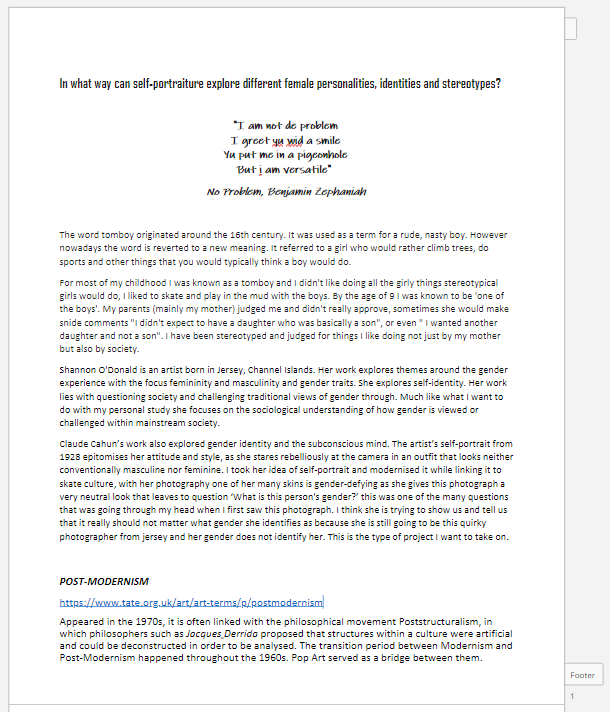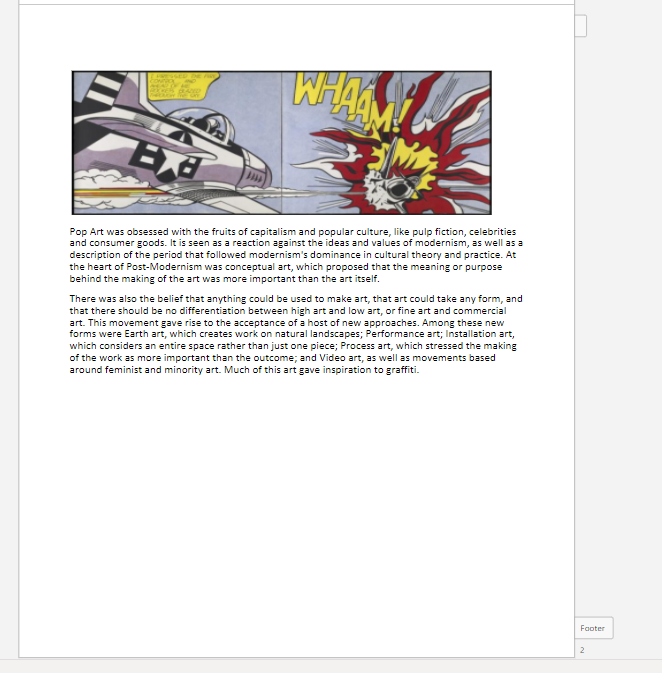

Essay question:
In what way can self-portraiture explore different female personalities, identities and stereotypes?
Opening quote:
“I am not de problem
I greet yu wid a smile
Yu put me in a pigeon hole
But i am versatile”
No Problem, Benjamin Zephaniah
Introduction (250-500 words):
My area of study
The word tomboy originated around the 16th century. It was used as a term for a rude, nasty boy. However nowadays the word is reverted to a new meaning. It referred to a girl who would rather climb trees, do sports and other things that you would typically think a boy would do.
For most of my childhood I was known as a tomboy and I didn’t like doing all the girly things stereotypical girls would do, I liked to skate and play in the mud with the boys. By the age of 9 I was known to be ‘one of the boys’. My parents (mainly my mother) judged me and didn’t really approve, sometimes she would make snide comments “I didn’t expect to have a daughter who was basically a son”, or even ” I wanted another daughter and not a son”. I have been stereotyped and judged for things I like doing not just by my mother but also by society.
“I am not de problem
I greet yu wid a smile
Yu put me in a pigeon hole
But i am versatile” By Benjamin Zephaniah
Artists I will be analysing
Shannon O’Donald is an artist born in Jersey, Channel Islands. Her work explores themes around the gender experience with the focus femininity and masculinity and gender traits. She explores self identity. Homework lies with questioning society and challenging traditional views of gender through her work she focuses on the sociological understanding of how gender is viewed or challenged within mainstream society.
Claude Cahun was a Surrealist photographer whose work explored gender identity and the subconscious mind. The artist’s self-portrait from 1928 epitomises her attitude and style, as she stares rebelliously at the camera in an outfit that looks neither conventionally masculine nor feminine. with her photography one of her many skins is gender-defying as she gives this photograph a very neutral look that leaves to question ‘What is this persons gender?’ this was one of the many question that was going through my head when I first saw this photograph. I think she is trying to show us and tell us that it really should not matter what gender she identifies as because she is still going to be this quirky photographer from jersey and her gender does not identify her.
Historical/ theoretical context within art
Modernism, the age of enlightenment. It was the shift in the late 1800s to modernism can be partly credited to new freedoms enjoyed by artists. It was a shift away from believing that god is going to save us from all evil and towards science or philosophers who might create something that would be our saving grace and actually help us. For example creating medicine like pain killers and vaccines that to this day are used to reduce the pain in cancer patients who are going through chemotherapy and the COVID-19 vaccine that trains the immune system to fight.
At the time, the growing field of psychology thanks to people like Sigmund Freud turned the analysis of human experiences inward and encouraged a more abstract kind of science and thinking. Essentially this inspired the visual arts to follow. With shifts in technology creating new materials and techniques in art-making, experimentation became more possible meaning it gave the art work a wider reach. Printing advances in the late 1800s meant posters of artwork widened the public’s awareness of art and design and conveyed experimental ideas into popular culture.
Modernism makes references to things inside the art itself. For example, from composition, material, skills, techniques, all the way to the process. Modernism in art holds a belief in the individual genius of the artist, a desire for originality, a thirst for the new, and reverence for the precious, unique art object. Modernism is concerned with ‘object rather than subject, creator rather than spectator.’
A key movement for this shift was The Dada movement took experimentation further by rejecting traditional skill and launching an all-out art rebellion that embraced nonsense and absurdity. Dadaist ideas first appeared in 1915, and the movement was made official in 1918 with its Berlin Manifesto. Traditionally, a painter was commissioned by a financier to create a specific work. The late 19th century witnessed many artists capable of seizing more time to pursue subjects in their personal interest.
Modernism reached its peak with Abstract Expressionism, which began in the late 1940s in the United States. Moving away from commonplace subjects and techniques, Abstract Expressionism was known for oversized canvases and paint splashes that could seem chaotic and arbitrary. Each Abstract Expressionist work functioned as both a document of the artist’s subconscious and a map of the physical movements required to create the art. Painter Jackson Pollock became famous for his method of dripping paint onto canvas from above.
- Essay question:
- Opening quote
- Introduction (250-500 words): What is your area study? Which artists will you be analysing and why? How will you be responding to their work and essay question?
- Introduction (250-500 words). Think about an opening that will draw your reader in e.g. you can use an opening quote that sets the scene. You should include in your introduction an outline of your intention of your study e.g. what and who are you going to investigate. How does this area/ work interest you? What are you trying to prove/challenge, argument/ counter-argument? What historical or theoretical context is the work situated within. Include 1 or 2 quotes for or against. What links are there with your previous studies? What have you explored so far in your Coursework or what are you going to photograph? How did or will your work develop. What camera skills, techniques or digital processes in Photoshop have or are you going to experiment with?
- Pg 1 (500 words): Historical/ theoretical context within art, photography and visual culture relevant to your area of study. Make links to art movements/ isms and some of the methods employed by critics and historian.
- Paragraph 1 Structure (500 words) : Use subheading. This paragraph covers the first thing you said in your introduction that you would address. The first sentence introduces the main idea of the paragraph. Other sentences develop the subject of the paragraph.
- Pg 2 (500 words): Analyse first artist/photographer in relation to your essay question. Present and evaluate your own images and responses.
- Pg 3 (500 words): Analyse second artist/photographer in relation to your essay question. Present and evaluate your own images and responses.
- Conclusion (250-500 words): Draw parallels, explore differences/ similarities between artists/photographers and that of your own work that you have produced
- Bibliography: List all relevant sources used
- Research and identify 3-5 literary sources from a variety of media such as books, journal/magazines, internet, Youtube/video .
- Begin to read essay, texts and interviews with your chosen artists as well as commentary from critics, historians and others.
- It’s important that you show evidence of reading and draw upon different pints of view – not only your own.
- Take notes when you’re reading…key words, concepts, passages

Overall the premise of your essay is good and I like the opening quote by Zephaniah and that you begin essay with a personal experience of being called a tomboy. Add here what your photographic responses are and how they challenge the tomboy stereotype etc.
The introduction needs a little structuring to make it sentences flow better. For example remove Artists I will be analysing
Pg 1: I would position the work of Cahun / O’Donnell within feminism / gender studies which are linked to postmodernism and not modernism – see texts below
Literary sources key texts: Have you identified any? There is no evidence of any reading around the subject by the use of direct quotes or paraphrasing from sources.
Read these:
Amelia Jones The “Eternal Return”: Self-Portrait Photography as Technology of Embodiment
https://hautlieucreative.co.uk/photo17a2e/wp-content/uploads/sites/22/2017/03/Jones_Eternal-Return.pdf
Andela-Kelly_Self-Image_personal-is-political
https://hautlieucreative.co.uk/photo21al/wp-content/uploads/sites/41/2021/01/Andela-Kelly_Self-Image_personal-is-political.pdf
For information on Cahun and her work and how it influenced Shannon go to my blog post here an scroll down to where it reads GENDER
https://hautlieucreative.co.uk/photo21al/2020/10/09/love-rebellion-part-3-art-activism/
+ read this essay by past student
To what extent does Surrealism create an unconscious representation of one’s inner conflicts of identity and belonging?
https://hautlieucreative.co.uk/photo20al/2020/02/10/final-essay-2/